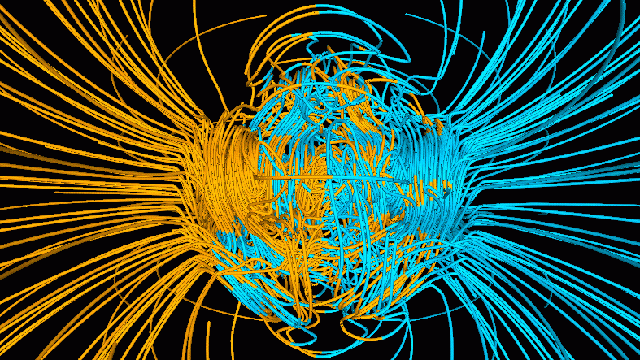
A computer simulation shows the Earth's magnetic field lines and two poles, with blue lines directed inward and yellow lines directed outward. (Gary A. Glatzmaier / UCSC)
The Earth's magnetic field is changing at an increasing rate, throwing off airports and altering the aurora borealis -- and its effect on ordinary compasses could mean the difference between homeward bound and hopelessly lost.
Earth’s northernmost magnetic point -- or magnetic north -- is distinct from its geographic North Pole, and scientists have long known that the magnetic poles are on the move.
But the magnetic poles have been moving faster lately, sliding towards Siberia at 34 miles per year at a speed that's accelerated 36 percent over the last 10 years, according to the United States Geological Survey, or USGS.
Since compasses rely on magnetic north to point you in the right way up the trail, the average $2-dollar model could very well point you in the wrong direction. Depending on location and journey length, unaware hikers or boaters could find themselves hundreds of miles off course if they don’t calibrate for the shift, experts said.
“At Washington D.C., the compass points 10 degrees to the west of true north," Jeffrey Love, USGS advisor for geomagnetic research, told FoxNews.com. "And this is increasing at Washington at a rate of about 1/10 of a degree per year.”
But don't touch that calibration dial just yet: The accuracy of compasses fluctuates with the field, he said, meaning compasses are more or less accurate depending on where you use them.
“It's different at different places on the earth,” Love said.
The magnetic shift is costing the aviation and marine industries millions of dollars to upgrade navigational systems and charts, Florida's Sun Sentinel reported.
"You could end up a few miles off or a couple hundred miles off, depending how far you're going," Matthew Brock, a technician with Lauderdale Speedometer and Compass, a Fort Lauderdale company that repairs compasses, told the paper.
Luckily for the younger generation, modern GPS technology is able to account and adjust for magnetic north’s deviation, also called magnetic declination. And scientists reassure the general public that the average individual will most likely not be affected at all by the shift in the magnetic field.
But hikers should be aware: The shift adds up to a one-degree difference in compass direction every ten years, Love said.
A spokesman for the National Park Service says cartographers aren’t scrambling to update their maps any time soon.
“We haven’t issued any warnings to hikers, and we don’t really plan to do that,” Jeffrey Olson, a representative for the National Park Service, told FoxNews.com. “Many or most trail guides will provide hikers with the location of the pole, and then they can feed those coordinates into any GIS.” A Geographic Information System is anything that works with location data. “That will help them find their way back.”
There are other effects to the roaming pole as well: Americans will be less likely to see the aurora borealis, for example.
“As the pole of the magnetic field migrates towards Siberia, the latitude that we observe the aurora borealis will increase for America,” Love told FoxNews.com. “It’s easier to see at higher latitudes. The optimal spot right now to see it is Fairbanks, Alaska, but it will slowly move north from there.”
And there have been some inconveniences for the Federal Aviation Administration, too. Airports across the country have repainted their runways so as to be more precise in terms of latitudinal and longitudinal coordinates, and many are planning to adjust in the future.
The polar shift is directly related to the movement of Earth’s magnetic field, which in turn, is related to the movement of Earth’s liquid iron core. The core is in a constant state of convection, or the transfer of heat within fluids. Since the core is convecting, it produces what Love referred to as a “naturally occurring electrical conductor.” And with electric current comes the magnetic field.
Fluctuations in the magnetic field have occurred for hundreds of thousands of years, so the shifting pole doesn’t exactly worry scientists. Sometimes the movement is slow, sometimes fast. The rapidity of the change has to do with the amount of activity going on in the earth’s core. But over time, the axel pole and the magnetic pole eventually equal one another.
“It’s a mathematical construct,” John Tarduno, professor of geophysics at the University of Rochester, told FoxNews.com. “The magnetic field is calculated over the entire planet. So when we think of the pole moving a large amount, we’re really talking about the magnetic field changing on a time scale. It’s true that that pole will wander around the true axis pole. But over thousands of years, the axel pole and magnetic pole will average to be in the same location.”
That's small consolation for someone looking to find their way home with a compass, of course.
Add to the ever evolving nature of Earth’s magnetism the fact that the overall magnetic field has been decreasing as well. Scientists have only been able to measure the intensity of the field since the 1830s, but ever since then, its strength has been on the decline, having decreased by about 10% since it was first measured. But for those concerned with this polar shift -- or even a possible polar reversal -- Love says there is no need to worry in our lifetime.
“Reversals -- which is the changing of the polarity of the magnetic field -- that typically takes about 10,000 years to happen,” Love told FoxNews.com. And “10,000 years ago civilization did not exist. These processes are very slow and therefore, we don’t have anything to worry about.”




















